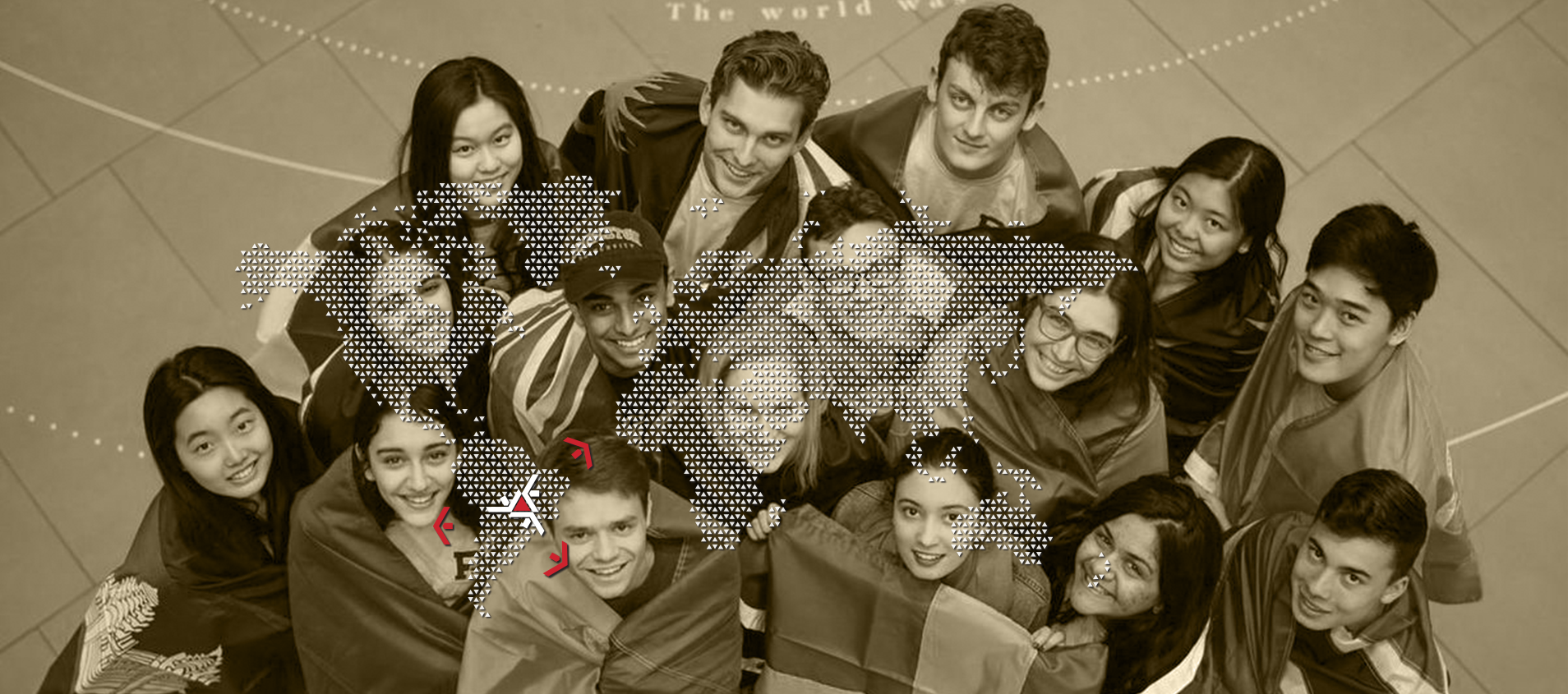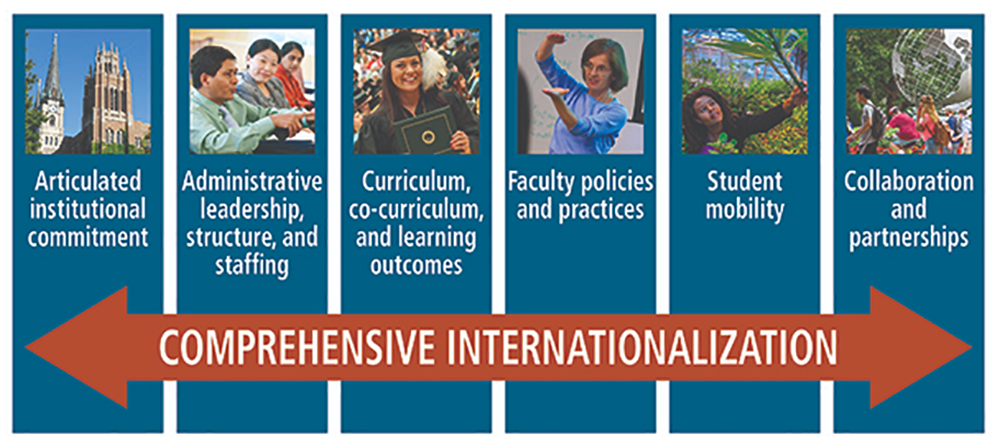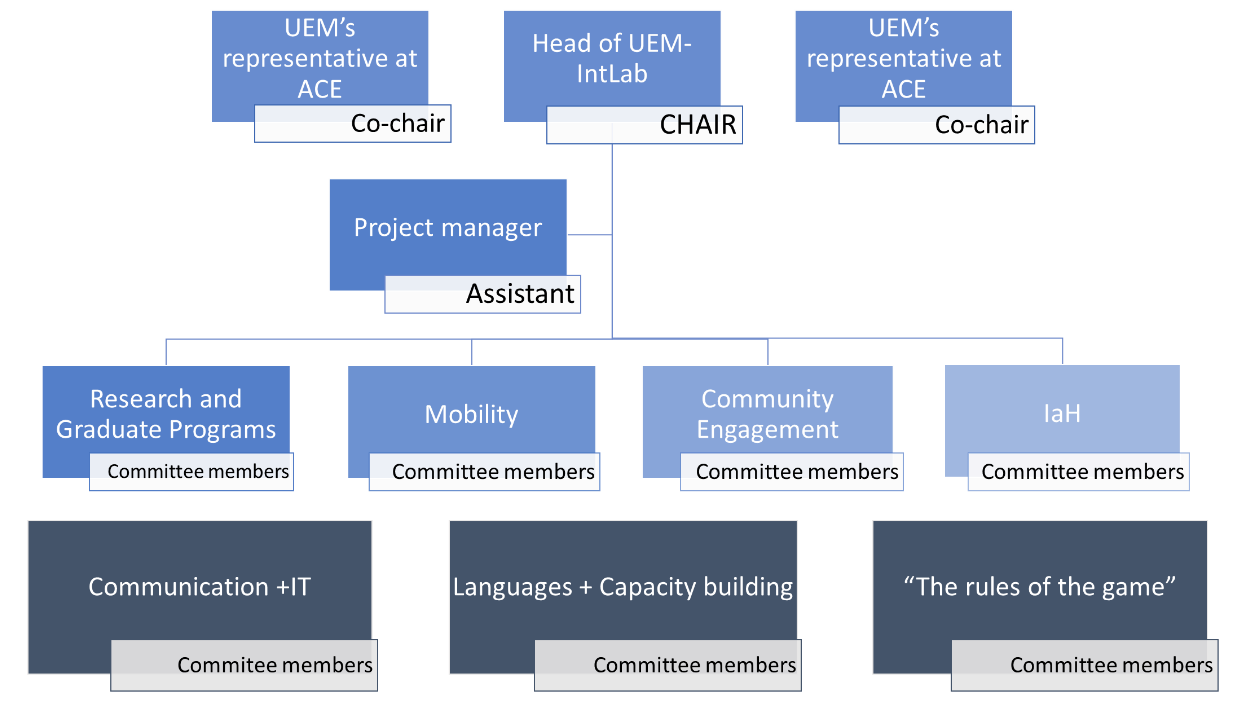
Internationalization Laboratory at UEM

What is UEM-IntLab
UEM-IntLab model

In July 2019, the State University of Maringá (UEM) was invited to be part of the ACE Internationalization Laboratory, a program of the American Council of Education (ACE). In our country, this initiative is funded by CAPES and Fulbright Commission Brazil. In its 17th cohort, it was the first time that Brazilian institutions took part in that program, and UEM was among the three universities selected by Capes (together with UFG and UFPA).
The aim of the program is to develop a strategic internationalization plan, through a process that encompasses articulating institutional goals, mapping the current internationalization status at university and constructing a new model of internationalization, based on the one for comprehensive internationalization.
At UEM, our initial efforts were to think about a framework for our own comprehensive internationalization. We adapted the ACE’s model to our reality, considering seven different axes:
• 03 Crosscut Axes: languages & capacity building, communication & IT, and “the rules of the game”
• 04 Focal Axes: research and graduate programs, mobility, community engagement, and internationalization at home.
The Internationalization model at UEM
The American Council of Education (ACE) defines comprehensive internationalization as “[…] a strategic, coordinated process that seeks to align and integrate policies, programs, and initiatives to position colleges and universities as more globally oriented and internationally connected institutions”. ACE model for comprehensive internationalization is illustrated below.
ACE Model for Comprehensive Internationalization

Source: ACE.
At UEM, the head of the International Office and the Director of Research were nominated to represent UEM at the Program. Initial efforts were to think about a framework for our own needs towards comprehensive internationalization. Compared to US universities, UEM has some key differences:
- As a university in Brazil, the official language is Portuguese, which brings us an extra challenge when it comes to foreign languages. In addition, we need to consider different teaching methodologies and tools to create more flexible and global learning curricula;
- As a Brazilian public university, our institutional environment (legislation framework) is much more complex and less flexible, which makes us give a special attention to “the rules of the game” for smoothing over the comprehensive internationalization process;
- As a public and tuition-free university, our information system and IT are more “rigid”, and our marketing and communication strategies and tools are not so focused on advertising and attracting stakeholders’ attention.
With that in mind, we adapted the ACE’s model to our reality. UEM-IntLab model has seven different axes with different topics of interest.
| UEM-IntLab Axis | Some topics of interest |
| Languages & capacity building |
|
| Communication & IT |
|
| "The rules of the game" |
|
| Research and Graduate Programs |
|
| Mobility |
|
| Community engagement |
|
| Internationalization at Home |
|
Steering Committee

One of the first actions at UEM-IntLab was to assemble a leadership team, called Grupo de Trabalho de Internacionalização (GT-Inter) (working group on internationalization), considering leading competences and skills on the seven axes. Nominated by the Rector, GT-Inter have been working on:
- Creating subcommittees with staff, faculty and students, for each axis
- Constructing the initial ideas on comprehensive internationalization and its strategic value for university
- Understanding the importance, contributions, and the interrelations between axes for implementing comprehensive internationalization at UEM
- Building key performance indicators and corresponding questionnaires for surveys with the university community
- Gathering secondary data, documents, and information about internationalization at UEM
- Analyzing the internationalization at UEM, through a diagnosis report
- Designing an action plan for comprehensive internationalization at UEM.
GT-Inter englobes 16 members, among provosts, directors, and faculty with different expertise, from all colleges. It also comprises representatives from regional campuses and the industry sector. The representatives of UEM at ACE (profs. Sandra Schiavi and Luiz Cotica) are part of GT-Inter. The group is headed by Prof. Julyerme Tonin.
Headed by one or two members of Gt-Inter, each axis has a subcommittee with faculty, staff and students. Subcommittees discuss and bring ideas and proposition for specific theme and complementary subjects in UEM-IntLab model. In total, UEM subcommitees englobe nearly 50 members, among faculty, staff, and students.
News room
Resources
INTLAB/UEM
Publications
1) Updating the definition of internationalization
KNIGHT, J. (2015). Updating the definition of internationalization. International Higher Education, n. 33, 2015.
2) Globalized Internationalization: Implications for Policy and Practice
JONES, Elspeth & de Wit, Hans. (2014). Globalized Internationalization: Implications for Policy and Practice. Spring.
3) Connecting Classrooms: Using Online Technology to Deliver Global Learning
ACE (2016). Internationalization in Action, SPECIAL EDITION Connecting Classrooms: Using Online Technology to Deliver Global Learning
4) Critical internationalization studies at an impasse: making space for complexity, uncertainty, and complicity in a time of global challenges
Stein, Sharon. (2019). Critical internationalization studies at an impasse: making space for complexity, uncertainty, and complicity in a time of global challenges. Studies in Higher Education. 1-14.
1) ACE Internationalization Laboratory (site).
Disponível em: https://www.acenet.edu/news-room/Pages/ACE-Internationalization-Laboratory.aspx
2) Comprehensive Internationalization (site)
Disponível em: https://www.acenet.edu/Research-Insights/Pages/Internationalization/Comprehensive-Internationalization.aspx
3) INTERNATIONAL PARTNERSHIPS: Part One: Definitions and Dimensions
Disponível em: https://www.acenet.edu/news-room/Documents/IIA-Intl-Partnerships-P1-Final.pdf
4) INTERNATIONAL PARTNERSHIPS: Part Two: Strategic Planning
Disponível em: https://www.acenet.edu/Documents/2017-Jan-IIA-Intl-Partnerships-Pt2.pdf
5) INTERNATIONAL PARTNERSHIPS: Part Three: A Hub and Spokes—Configuring Campus Stakeholders for Partnership Success
Disponível: https://www.acenet.edu/Documents/IIA-Intl-Partnerships-Part-3.pdf
6) INTERNATIONAL PARTNERSHIPS: Part Four: From Strategy to Implementation - Launching and Managing Individual Partnerships
Disponível em: https://www.acenet.edu/news-room/Documents/IIA-partnerships-Chad-final.pdf
